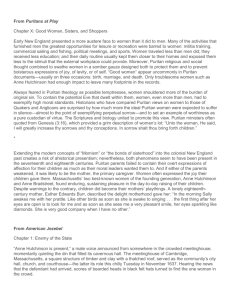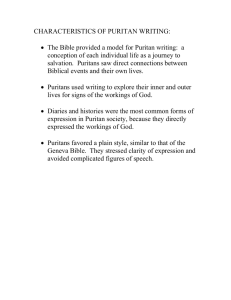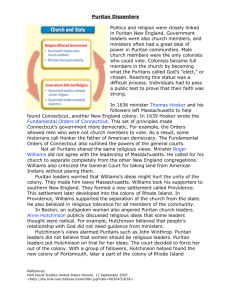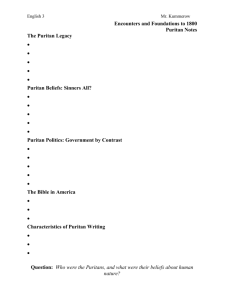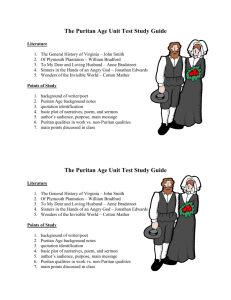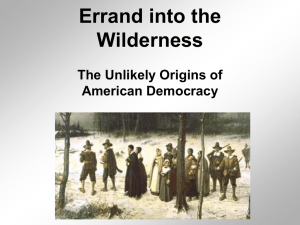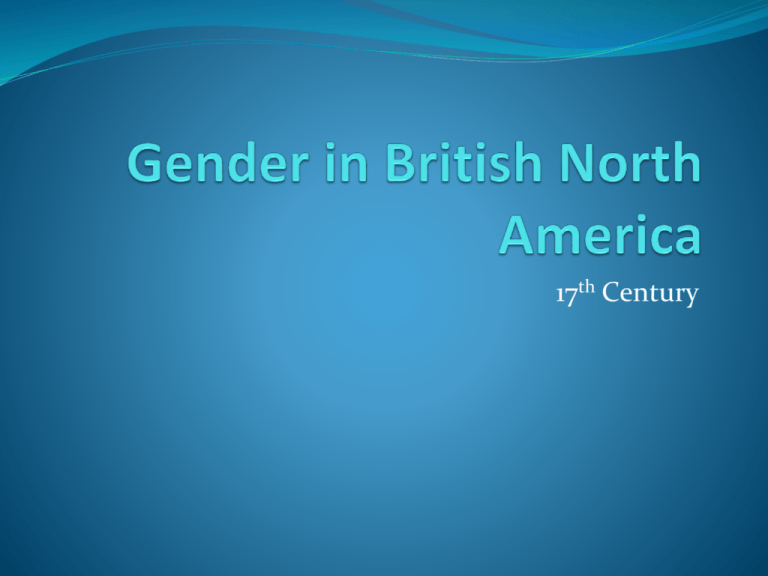
17th Century
Overview, North versus South
North = Massachusetts Bay Colony, Pennsylvania,
Maine, etc.
–Families
–Intentional Communities (utopian goals)
South = Chesapeake Bay Colony, etc.
–Single (wealthy) males
–Indentured (poor) females and males
–Slaves
Religious beliefs
Protestant and Catholic religious beliefs shape ideas
about proper role of women
Sin of Eve means all women untrustworthy
Eve’s disobedience to God means she should be under
the authority of Adam to limit her potential for
transgression
Paul: “women should keep silence in the churches” –
taken to mean women should not teach, nor hold
authority over men in church
Religious beliefs
Patriarchy is the biblically ordained social order and
correctly expressed in all things from the home to
church to the state
Within a patriarchy, people need to understand their
place within it, act accordingly, and structure their
expectations to meet their role
Legal status
Married women are “feme covert”
no legal identity after marriage (legal status “covered” by
their husbands’ = “two become one”)
Not able to own personal property – what she brings into
the marriage belongs to husband (can be seized for
debts, etc)
May own real estate, but cannot control it
“feme sole traders” or deputy husbands in extreme
circumstances
Single women are “feme sole” with the same legal rights
as men, no political rights
Legal status
Dower Rights
Set amount (usually 1/3) of “life interest” in her
husband’s real property after his death
e.g. can have 1/3 harvest from farm
Called “widow’s thirds”
Primogeniture
Inheritance generally goes to eldest son unless will
declares otherwise
Wealthy fathers may try to protect daughter’s
inheritance
Poor Laws
Destitute widows or orphans (mainly) must be cared for
by the community
Puritan beliefs
Personal understanding of God and self
Individual bible study and interpretation
Constant self-examination and policing
Constant self-doubt
Living example of adherence to God’s laws
Puritans and Women’s Souls
Patriarchal authority through the church (St. Paul’s
edict: “Let the women keep silent in the churches.” -- 1
Corinthians 14:34)
Anne Hutchinson told: "You have stepped out of your place,
you have rather been a husband than a wife, and a preacher
than a hearer.“
Puritan belief: "the soul consists of two portions,
inferior and superior; the superior is masculine and
eternal; the feminine inferior and mortal."
Puritan families
Church covenant mirrors individual covenant:
Individual congregations, whose leaders have
demonstrated their conversions, agreed that the Gospel
would be preached and discipline maintained among
the congregation, then God would bestow “saving grace”
within the church.
“National” covenant means Puritans also apply these
ideas about covenant and mutual assent to state
Puritan families
Coming from stratified society where status and its
meaning are vital: deference, respect, order
Somewhat mitigated by fact many arriving initially from
middle strata of English society
Family is core of Puritan society – mirrors larger society
and prepares members for Godly lives (as befits saints)
Familial hierarchy and recognition of place in it vital to
understanding of larger society and individual
responsibilities/order: family covenant
Orderly families = orderly society
John Winthrop, from “A Model of Christian Charity”
1630
God Almighty…hath so disposed of the condition of
mankind [that] some must be rich, some poor, some high
and eminent in power and dignity; others mean and in
subjection…
The Reason Hereof:...so that the rich and mighty might not
eat up the poor, nor the poor and despised rise up against
their superiors and shake off their yoke; second, in the
regenerate in exercising His graces in them, as in the great
ones their love, mercy, gentleness, temperance, &c.; in the
poor and inferior sort, their faith, patience, obedience,
&c.....
When God gives us a special commission He wants it
strictly observed in every article....
Puritan families
“…a familie is a little Church, and a little common-
wealth, at least a lively representation thereof, whereby
triall may be made of such as are fit for any place of
authoritie, or of subjection in Church or
commonwealth. Or rather it is as a schoole wherein
the first principles and grounds of government and
subjection are learned: whereby men are fitted to
greater matters in Church or common-wealth.”
William Gouge, Of Domesticall Duties (1622)
Puritan families
Cohort to MA includes preachers, merchants,
primarily families
2:3 sex ratio (very good for new settlement)
Main unit of economic production (external and
household economies) and property transfer
Main educational, religious, political unit
Desire for order, godly lives of citizens
Town layouts
Policing of all, including unmarrieds
Puritan women
“he for God only, she for God in him” Milton Paradise
Lost
Women and men are equally able to be elect and to
develop understandings of God’s word and many
women more pious and devout than men.
Subordinate status and pain of childbirth makes them
more open to spiritual (deaths during
childbirth/childbed mean it is constant part of women’s
lives – either directly or indirectly)
Puritan women
Marriage key event in women’s lives
Choice frequently guided by family
Type of partnership with shared responsibilities
“to guid the house &c. not guid the Husband” (Increase
Mather sermon 1672)
Husband should “make his government of her as easie
and gentle as possible; and strive more to be lov’d than
fear’d: though neither is to be excluded” (Benjamin
Wadsworth, Well-Ordered Family)
Puritan women
Responsibilities lay inside a specific “private” purview
– maintaining home, household economy, children,
servants, but could be “deputy husband” under
specific circumstances
“An old (or Superannuated) Maid, in Boston, is
thought such a curse as nothing can exceed it, and
look'd on as a dismal Spectacle.“ -- John Dunton,
bookseller, 1686
Puritan women
“Goodwife” or goody (80-90 percent of Puritan women
marry)
Well-ordered home, frugal, clean
Puritan women
Women crucial to household economy
Household production – individual and supervision of
production
Early market society means home production crucial for most
Egg and butter money, candles, spinning
“women’s work” for wages as cities and towns expand
Informal authority
Midwives
observers
“exemplars”
Adultery
Male and female adulterers punished differently –
Illustrates different role of women
Male adulterers had wronged their partner’s husband
Female adulterers had wronged their own husband AND
the wife, children, and relations of their partner
Puritan women
Women’s sexual nature is welcomed within the bounds
of marriage b/c it is necessary to reproduction
Bible says to multiply
Strengthens “marriage covenant”
Orgasm necessary for conception (difficulty of rape
suits)
Heavy punishments for sexual contact outside of
marriage
Talking about good and bad sexuality meant to
educate children - public punishments and sermons:
“F is for fornication”
Puritan women
Essex County Court records from 1641 and 1685, 135 married
women and 131 unmarried women cited for fornication
Brides with “early babies” fall into same age category as
women who marry with 9-12 month children (early to mid
20s)
62 percent of unmarried mothers are between 15 and 20 and
the fathers named avg 25-29 yrs
Single mothers cannot duplicate godly family model and
are in economic danger – may become a drain; woman’s
carnal nature has been tapped
Midwives as witness
Puritan women
Childbirth
Communal activity
Expression of status of mother and caregivers
Risky
Anne Bradstreet – 8 children, 7 who outlived her
Mercy Bradstreet – 3 children lost, died in childbirth at 28
Average woman has 7 children, with last at age 37
Does not include stillbirths or miscarriages
Most women spend adult lives childbearing and childrearing
High infant survival rates – could read 80% (London was 20%
and Chesapeake could be 40-50%)
Multi-generation families in communities
Elizabeth Freake
and daughter, 1670
Salem Witch Trials, 1692
Women in the colonies almost always women – European
witchcrazes also targeted men
Most accused exhibit behavior that challenges “goodwife”
image
Tituba
Bridget Bishop (fought with husbands, kept taverns, dressed
immodestly)
Sarah Good (homeless, destitute, mumbled to self) H
As hunt continues, others pulled in
Rebecca Nurse (elderly widow who had never remarried)H
John Proctor (tavern owner, objected to accusations towards
his wife) H
Salem Witch Trials, 1692
20 executed (1 by pressing)
Up to 13 died in prison
Why?
Teenage hysteria bolstered by parents
Ergot blight
Economic and social tension
Women who had unsettled social order
Frontier unrest, Indian victories
King Phillip’s War, 1676
Captive for 11 weeks
“savages” “barbarous”
“dirty”
Anne Hutchinson
Daughter of a clergyman, one of 13 children.
She was independent minded, assertive, and well trained in
religious discourse by her father.
At age 21, she married William Hutchinson.
She was a good Puritan woman
16 pregnancies in all.
She was a good homemaker and housekeeper.
Practiced folk medicine and acted as a midwife when called
upon.
•In 1634, she and her husband came to America in a group
led by the Reverend John Cotton, one of the primary
Puritan divines. •Opened her home to post-church
discussions.
Anne Hutchinson
At these meetings 60 men and women discussed theology
Hutchinson became a leader and teacher on the newer ideas of
the “Puritan Divines” led by John Cotton
Local authorities told her to stop – Cotton was the enemy of the
current governor, John Winthrop.
Hutchinson brought to trial 1637
Banished for “disorderlyness”, then appealed
Imprisoned for a year and brought to trial in church a second
time in 1638, convicted and banished.
58 Bostonians took up arms in support of her.
She left colony with small group supporters, followed by husband
and children.
Later she and her children killed by Indians; husband had
already died
Gender in Anne Hutchinson’s Case
•Anne Hutchinson believed that women should teach and
preach because they were as likely as men to have a true
covenant of grace with God.
John Winthrop felt that too much reading and studying
would drive a woman mad.
He found Hutchinson haughty, aggressive, disorderly,
unfeminine, and suspected her of practicing free love and
witchcraft.
John Winthrop feared this woman, and particularly her
influence over other women.
Women were too weak and unintelligent to resist her
message
weak women would, like Eve, lead their husbands to evil.
Gender in Anne Hutchinson’s Case
At her second religious one, Hutchinson was told that her
problem was that she would "rather be a Husband than a Wife
and a Preacher than a Hearer; and a Magistrate than a Subject."
In other words, she lacked submissive spirit and dependent
demeanor of a true Puritan woman.
The charge of witchcraft raised at the end of the second trial.
Told story of a deformed baby that Hutchinson had delivered as
a midwife as evidence of her being a witch.
Winthrop continued to harass Hutchinson in exile.
She was seriously ill after her long confinement and at age 46, in the
final stages of her last pregnancy.
She delivered prematurely, the child died.
Winthrop sent for details and published, "that she had produced
30 monstrous births, or thereabouts."
Southern Colonies
1607 Virginia Company: Jamestown
men: search for riches, resources
first women in 1608
“These Savages have no particular propertie in any
parcell of that country, but only a general residence
there, as wild beasts have in the forest” – Robert Gray
“A Good Speed to Virginia”
Cycle of violence and truces
Women in the Chesapeake
Unbalanced sex ratio
A few female “headrights” (50 acres of land – women
who bought own passage are eligible)
Easier marriage – sex ratio and VA Company wants more
married men b/c they cause less trouble
Marrying Native women not a respectable option after earliest
period
Female indentured servants
70 to 85 percent of all emigrants in first half of 17th Century are
indentured
Cannot marry until indenture is served:
Later marriage = fewer children
Family in the Chesapeake
Families fragile for biological reasons (malaria, etc.)
life expectancy only 43 years
most marriages lasted only 7 years
men outnumber women 3 to 1
pregnant women especially vulnerable to malaria
few children reach adulthood with both parents living
(and almost no grandparents)
widows prized (inheritance); remarried quickly
Family in the Chesapeake
Coming from stratified society where status and its
meaning are vital: deference, respect, order
Intent to model English gentry
Familial hierarchy and recognition of place in it vital to
understanding of larger society and individual
responsibilities/order
Orderly families = orderly society
Marriage in Chesapeake
Institution of marriage shaped by sparse settlement
and lack of community control as existed in New
England
As result, many early marriages were informal,
“common-law”
But with fragile families, inheritance becomes an issue
As result, pressure to form more rigid and solemnized
marriages
Marriage in Chesapeake
For upper-class, model marriages were English
aristocrats – women firmly subordinate, expected to
turn blind eye to infidelity, etc.
Tension as racial inequalities increase
Sexual violence
Gender expectations racialized
Comparison
Marriage differed in British colonies north and south,
largely as a result of the institution of slavery.
(While there was slavery in the North, it did not predominate
as a social form.)
In South, where slavery resulted in creation of significant
peoples of mixed race and numbers of illegitimate
children, control of white, landed or upper class women’s
sexuality (fertility) became very important.
Male privilege was protected in South by civil law which
forbade divorce for male adultery (although did allow for
separation in certain circumstances).



